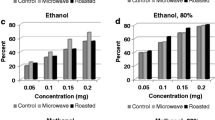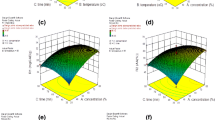Abstract
We investigated the effects of different autoclave extraction times (1-6 h) on the antioxidant, antidiabetic, and anti-inflammatory activities of phenolic compounds isolated from graviola (Annona muricata) leaves. In terms of yield and content of total polyphenols, total flavonoids, rutin, and kaempferol-3-O-rutinoside, the optimal extraction time was 4 h. At this time point, water extracts from graviola leaves (WEG) exhibited the highest DPPH radical scavenging activity, ferric reducing antioxidant power, and α-glucosidase inhibitory activity. The α-glucosidase inhibitory activity of WEG was significantly stronger than that of acarbose. Furthermore, WEG significantly suppressed lipopolysaccharide-induced nitric oxide production in RAW 264.7 cells and inhibited UVB-induced activator protein-1 (AP-1)-dependent transcription in human keratinocytes. In conclusion, WEG can be used as functional food ingredients in the food industry.
Similar content being viewed by others
References
Leboeuf, M., A. Caré, M. E. Tohami, J. Pusset, P. Forgacs, and J. Provost (1982) Alkaloids of annonaceae. XXXV. alkaloids of Desmos tiebaghiensis. J. Nat. Prod. 45: 617–623.
Ayaz, F. A., S. Hayirlioglu-Ayaz, J. Gruz, O. Novak, and M. Strnad (2005) Separation, characterization, and quantitation of phenolic acids in a little-known blueberry (Vaccinium arctostaphylos L.) fruit by HPLC-MS. J. Agric. Food Chem. 53: 8116–8122.
Nessa, F., Z. Ismail, S. Karupiah, and N. Mohamed (2005) RP-HPLC method for the quantitative analysis of naturally occurring flavonoids in leaves of Blumea balsamifera DC. J. Chromatogr. Sci. 43: 416–420.
Lee, C. H., C. G. Krueger, J. D. Reed, and M. P. Richards (2006) Inhibition of hemoglobin-mediated lipid oxidation in washed fish muscle by cranberry components. Food Chem. 99: 591–599.
Bansal, P., P. Paul, J. Mudgal, P. G. Nayak, S. T. Pannakal, K. I. Priyadarsini, and M. K. Unnikrishnan (2012) Antidiabetic, antihyperlipidemic and antioxidant effects of the flavonoid rich fraction of Pilea microphylla (L.) in high fat diet/streptozotocin-induced diabetes in mice. Exp. Toxicol. Pathol. 64: 651–658.
Nawwar, M., N. Ayoub, S. Hussein, A. Hashim, R. El-Sharawy, K. Wende, M. Harms, and U. Lindequist (2012) A flavonol triglycoside and investigation of the antioxidant and cell stimulating activities of Annona muricata Linn. Arch. Pharm. Res. 35: 761–767.
Son, Y. R., E. H. Choi, G. T. Kim, T. S. Park, and S. M. Shim (2016) Bioefficacy of Graviola leaf extracts in scavenging free radicals and upregulating antioxidant genes. Food Funct. 7: 861–871.
Acésio, N. O., G. S. Carrijo, T. H. Batista, J. L. Damasceno, M. B. Côrrea, M. G. Tozatti, W. R. Cunha, and D. C. Tavares (2017) Assessment of the antioxidant, cytotoxic, and genotoxic potential of the Annona muricata leaves and their influence on genomic stability. J. Toxicol. Environ. Health A. 80: 1290–1300.
Naczk, M. and F. Shahidi (2004) Extraction and analysis of phenolics in food. J. Chromatrogr. A. 1054: 95–111.
Arya, V., N. Thakur, and C. P. Kashyap (2012) Preliminary phytochemical analysis of the extracts of Psidium leaves. J. Pharmacogn. Phytochem. 1: 1–5.
Budaraju, S., K. Mallikarjunan, G. Annor, T. Schoenfuss, and R. Raun (2018) Effect of pre-treatments on the antioxidant potential of phenolic extracts from barley malt rootlets. Food Chem. 266: 31–37.
Mittal, M., M. R. Siddiqui, K. Tran, S. P. Reddy, and A. B. Malik (2014) Reactive oxygen species in inflammation and tissue injury. Antioxid. Redox Signal. 20: 1126–1167.
Lee, J., S. J. Ha, H. J. Lee, M. J. Kim, J. H. Kim, Y. T. Kim, K. M. Song, Y. J. Kim, H. K. Kim, and S. K. Jung (2016) Protective effect of Tremella fuciformis Berk extract on LPS-induced acute inflammation via inhibition of the NF-κB and MAPK pathways. Food Funct. 7: 3263–3272.
Ha, S. J., J. Lee, J. Park, Y. H. Kim, N. H. Lee, Y. E. Kim, K. M. Song, P. S. Chang, C. H. Jeong, and S. K. Jung (2018) Syringic acid prevents skin carcinogenesis via regulation of NoX and EGFR signaling. Biochem. Pharmacol. 154: 435–445.
Jung, S. K., K. W. Lee, S. Byun, N. J. Kang, S. H. Lim, Y. S. Heo, A. M. Bode, G. T. Bowden, H. J. Lee, and Z. Dong (2008) Myricetin suppresses UVB-induced skin cancer by targeting Fyn. Cancer Res. 68: 6021–6029.
Laksmitawati, D. R., A. P. Prasanti, N. Larasinta, G. A. Syauta, R. Hilda, H. U. Ramadaniati, A. Widyastuti, N. Karami, M. Arni, D. D. Rihibiha, H. S. W. Kusuma, and W. Widowati (2016) Anti-inflammatory potential of gandarusa (Gendarussa vulgaris Nees) and soursoup (Annona muricata L) extracts in LPS stimulated-macrophage cell (RAW264. 7). J. Nat. Rem. 16: 73–81.
Moghadamtousi, S. Z., E. Rouhollahi, M. Hajrezaie, H. Karimian, M. A. Abdulla, and H. A. Kadir (2015) Annona muricata leaves accelerate wound healing in rats via involvement of Hsp70 and antioxidant defence. Int. J. Surg. 18: 110–117.
AACC (1995) Approved Method of the AACC. 10th ed. St. American Association of Cereal Chemists, St. Paul, MN, USA.
Kähkönen, M. P., A. I. Hopia, H. J. Vuorela, J. P. Rauha, K. Pihlaja, T. S. Kujala, and M. Heinonen (1999) Antioxidant activity of plant extracts containing phenolic compounds. J. Agric. Food Chem. 47: 3954–3962.
Quettier-Deleu, C., B. Gressier, J. Vasseur, T. Dine, C. Brunet, M. Luyckx, M. Cazin, J. C. Cazin, F. Bailleul, and F. Trotin (2000) Phenolic compounds and antioxidant activities of buckwheat (Fagopyrum esculentum Moench) hulls and flour. J. Ethnopharmacol. 72: 35–42.
Liu, P., H. Kallio, and B. Yang (2014) Flavonol glycosides and other phenolic compounds in buds and leaves of different varieties of black currant (Ribes nigrum L.) and changes during growing season. Food Chem. 160: 180–189.
Ferruzzi, M. G., V. Böhm, P. D. Courtney, and S. J. Schwartz (2002) Antioxidant and antimutagenic activity of dietary chlorophyll derivatives determined by radical scavenging and bacterial reverse mutagenesis assays. J. Food Sci. 67: 2589–2595.
Benzie, I. F. and J. J. Strain (1996) The ferric reducing ability of plasma (FRAP) as a measure of “antioxidant power”: the FRAP assay. Anal. Biochem. 239: 70–76.
Zhang, L., S. Hogan, J. Li, S. Sun, C. Canning, S. J. Zheng, and K. Zhou (2011) Grape skin extract inhibits mammalian intestinal α-glucosidase activity and suppresses postprandial glycemic response in streptozocin-treated mice. Food Chem. 126: 466–471.
Vergara-Salinas, J. R., J. Pérez-Jiménez, J. L. Torres, E. Agosin, and J. R. Pérez-Correa (2012) Effects of temperature and time on polyphenolic content and antioxidant activity in the pressurized hot water extraction of deodorized thyme (Thymus vulgaris). J. Agric. Food Chem. 60: 10920–10929.
Palma, M., Z. Piñeiro, and C. G. Barroso (2001) Stability of phenolic compounds during extraction with superheated solvents. J. Chromatogr. A. 921: 169–174.
Biesaga, M. (2011) Influence of extraction methods on stability of flavonoids. J. Chromatogr. A. 1218: 2505–2512.
Gavamukulya, Y., F. Abou-Elella, F. Wamunyokoli, and H. AEl-Shemy (2014) Phytochemical screening, anti-oxidant activity and in vitro anticancer potential of ethanolic and water leaves extracts of Annona muricata (Graviola). Asian Pac. J. Trop. Med. 7: S355–S363.
Balkan, I. A., H. T. Doğan, G. Zengin, N. Colak, F. A. Ayaz, A. C. Gören, H. Kırmızıbekmez, and E. Yeşilada (2018) Enzyme inhibitory and antioxidant activities of Nerium oleander L. flower extracts and activity guided isolation of the active components. Ind. Crops. Prod. 112: 24–31.
Jung, S. K., S. J. Ha, Y. A. Kim, J. Lee, T. G. Lim, Y. T. Kim, N. H. Lee, J. S. Park, M. H. Yeom, H. J. Lee, and K. W. Lee (2015) MLK 3 is a novel target of dehydroglyasperin D for the reduction in UVB-induced COX-2 expression in vitro and in vivo. J. Cell. Mol. Med. 19: 135–142.
Jung, S. K., S. J. Ha, C. H. Jung, Y. T. Kim, H. K. Lee, M. O. Kim, M. H. Lee, M. Mottamal, A. M. Bode, K. W. Lee, and Z. Dong (2016) Naringenin targets ERK2 and suppresses UVB-induced photoaging. J. Cell. Mol. Med. 20: 909–919.
Tadera, K., Y. Minami, K. Takamatsu, and T. Matsuoka (2006) Inhibition of α-glucosidase and α-amylase by flavonoids. J. Nutr. Sci. Vitaminol. 52: 149–153.
Etxeberria, U., A. L. de la Garza, J. Campión, J. A. Martínez, and F. I. Milagro (2012) Antidiabetic effects of natural plant extracts via inhibition of carbohydrate hydrolysis enzymes with emphasis on pancreatic alpha amylase. Expert Opin. Ther. Targets. 16: 269–297.
Acknowledgements
This work was supported by the Technology development Program (C0452780) funded by the Ministry of SMEs and Startups (MSS, Korea).
The authors declare no conflict of interest.
Neither ethical approval nor informed consent was required for this study.
Author information
Authors and Affiliations
Corresponding authors
Additional information
Publisher’s Note Springer Nature remains neutral with regard to jurisdictional claims in published maps and institutional affiliations.
Rights and permissions
About this article
Cite this article
Choi, M., Kang, YR., Zu, H.D. et al. Effects of Time on Phenolics and in vitro Bioactivity in Autoclave Extraction of Graviola (Annona muricata) Leaf. Biotechnol Bioproc E 25, 9–15 (2020). https://doi.org/10.1007/s12257-019-0259-3
Received:
Revised:
Accepted:
Published:
Issue Date:
DOI: https://doi.org/10.1007/s12257-019-0259-3




